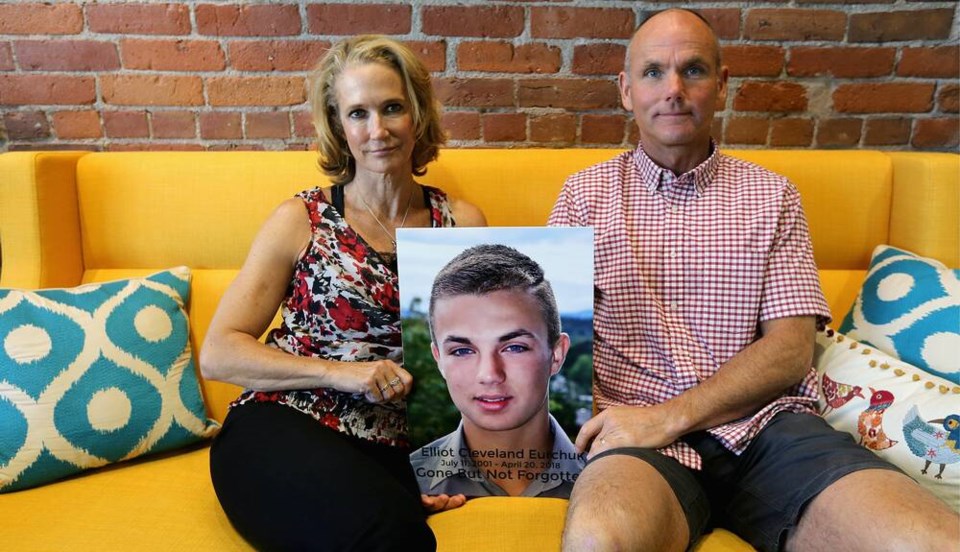It’s been nearly four years since a B.C. coroner’s inquest jury made recommendations in the death of Elliot Eurchuk, a 16-year-old Victoria boy who died from a toxic drug overdose in his bedroom.
Among the jury’s recommendations was that the Ministry of Health establish the first publicly funded residential substance-use disorder treatment centre on Vancouver Island for youth.
No such treatment facility has been created.
“Where are we now? Years later and none of the recommendations have come to fruition,” said Eurchuk’s mother, Rachel Staples. “I’ve been begging for these changes since my son died so no other parent will have to go through what I did.”
The need for quickened access to more publicly funded treatment and mental health care beds for youth has been reinforced after new data indicates illicit drug toxicity outpaces all other causes of death for British Columbians aged 10 to 18.
The B.C. Centre for Disease Control report showed 2022 was the first year that overdoses — of which the vast majority involved fentanyl — overtook other causes of death in the 10-to-18 age group. The year before, the leading cause of death was accidents.
Staples said she tried to help her son several times following an overdose before his death in April 2018.
“When a child in B.C. overdoses, they go to the ER where they are stabilized and often released without any treatment plan but rather a pamphlet in hand,” the mother said.
Elliot had become hooked on opioids after being prescribed them after four major surgeries in 2017. He eventually resorted to purchasing opioids off the dark web.
“Elliot was not offered medication-based treatment or anything by doctors following his overdoses and we couldn’t find any treatment centres or services on the Island to help,” said Staples.
The B.C. coroner’s inquest into the teen’s death also recommended the province add services to bridge the transition from hospitalization after an overdose to community-based outpatient services.
While some public health improvements have been made since Elliot’s death for youth in B.C., services aren’t matching the soaring need, Staples said.
Jennifer Whiteside, B.C.’s minister of mental health and addictions, acknowledged the government has more to do.
“The toxic drug crisis continues to have a devastating impact on families and communities in B.C. and the impact on children, youth is heartbreaking,” Whiteside said in a statement.
Of B.C.’s 3,237 publicly funded community substance use treatment beds, only 156 are currently designated for youth. These include 53 that were added this year as part of the province’s 2023 budget where $180 million was dedicated to youth mental health and substance use services.
Advancements also include the addition of 175 youth substance use workers and an expansion of Foundry Centres, which offer youths integrated mental illness and addiction care in cities across the province.
In the six years leading up to 2023, 142 youths died from suspected toxic drugs, according to a B.C. Coroners Service report.
Vancouver, Victoria and Surrey had the highest numbers of fatalities with more than 70 per cent happening in private residences. More than half of the deaths occurred when drugs were used alone.
Of the total deaths, the report indicates 62 per cent involved youths between 17 and 18 years old. Close to three-quarters had been or were receiving services from the Ministry of Children and Family Development.
James Wang, a Vancouver pediatrician who specializes in addiction medicine, said there are challenges in treating adolescents who use illicit drugs.
“There are not enough clinicians who specialize in youth substance use, so most of the care adolescents in B.C. are receiving comes from front-line workers, including ER doctors and nurses, and there hasn’t been much training.”
Wang said there is also a lack of research that explores proven measures of such health care in children.
“The more we learn, the more we’re seeing that there is a complexity to the issue,” he said.
“In most youth who use substances, there is often a co-occurring mental health issue or environmental stressor such as at home or at school among peers and possibly even a genetic predisposition that puts them at higher risk.”
In the absence of specialized treatment centres on the Island, Staples is working to establish the first mental health and substance use unit for youth at Victoria General Hospital.
“The acute care unit will have 12 treatment beds and specialized teams that involve families in patient care plans and connect them to resources back in their community,” the mother said.
While Island Health Authority plans to foot a portion of the bill for the specialized $15 million unit, Staples said she’s fundraising the rest with a group of interested parties.
“It would be the only good thing to come from Elliot’s death,” Staples said. “These kids are our future … but still, where will Island youth in the unit be sent for treatment once they are stabilized?”



